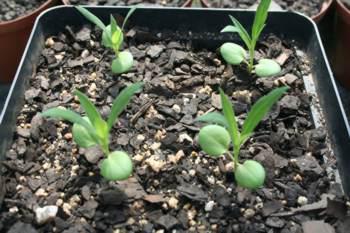Barleria dinteri
Barleria dinteri Oberm.
Family: Acanthaceae
Common names: leather leaf barleria (Eng.); Ludwigslust barleria (Afr.)
Introduction
This is one of the lesser known barlerias, suitable for a sunny spot in your garden.

Description
Description
A perennial herb or shrublet up to 300 mm high. Leaves leathery, dull green, oblong to oblanceolate, base tapering into a short petiole, apex ends in a sharp point, midvein and lateral veins prominent. Stems angular, young stems less woody and covered with hairs, internodes variable in length.
Flowers are yellow, solitary in the upper axils, short upper internodes between the uppermost flowers give the impression of a terminal inflorescence. Corolla 2-lipped, the upper lip 4-lobed, the lower lip entire and sometimes shorter than the upper lip; corolla subtended by stiff, spinous, lanceolate calyx lobes; corolla tube short and cylindrical. Stamens and stigma brightly coloured. Axillary spines 2-4 in clusters. Flowering time: November to March during which flowers appear sporadically.
Fruit a capsule, turgid and rounded at the base and the apex ends in a stout solid conical beak. There are 2 seeds per capsule. Ripe capsules explode, when moistened, to disperse the seed.
Conservation Status
Status
LC. (Least Concern).
Distribution and habitat
Distribution description
Occurs in Namibia, Botswana, Limpopo, Gauteng, Mpumalanga and Swaziland. In Limpopo plants grow on limestone-rich soils, in full sun.

Derivation of name and historical aspects
History
Named after Prof. Moritz Kurt Dinter (1868-1945), a German botanist famous for exploration in Namibia.
Ecology
Ecology
Barleria dinteri is pollinated by insects and attracts various species of butterflies.
Uses
Use
Barleria dinteri can be recommended as a garden subject. No cultural uses have been recorded.
Growing Barleria dinteri
Grow
Barleria dinteri can be propagated by seed or cuttings.
Collect the seeds as the capsules begin to turn brown. The seeds should be planted in a mixture of two parts good soil and one part compost. Place the seed tray in a shady spot. Water once a week. Seed germination takes place after 6-10 days. Transplanting seedlings into bags or pots should be done when the seedlings are more or less 100 mm high.

Barleria dinteri is difficult to grow from cuttings. Take semi-hardwood cuttings, 120 mm long, in summer. Treat the cuttings with hormone powder to stimulate root grow. Use a mixture of even parts soil and river sand as a growing medium. Put the container with cuttings in a shady place and water twice a week. Transplant the rooted cuttings after about three to four months into a good soil mixture. Expect a success rate of 30%.
References
- Obermeijer, A.A. 1931. A revision of the South African species of Barleria . Annals of the Transvaal Museum 15,2: 123-180.
- Van der Walt, R. 2009. Wild flowers of the Limpopo Valley. Retha van der Walt
Credits
Willem Froneman
Lowveld NBG
April 2013
Plant Attributes:
Plant Type: Ground Cover, Perennial, Shrub
SA Distribution: Gauteng, Limpopo, Mpumalanga
Soil type: Sandy
Flowering season: Late Summer, Autumn
PH: Alkaline
Flower colour: Yellow
Aspect: Full Sun
Gardening skill: Challenging
Special Features:
Horticultural zones








Rate this article
Article well written and informative
Rate this plant
Is this an interesting plant?
Login to add your Comment
Back to topNot registered yet? Click here to register.